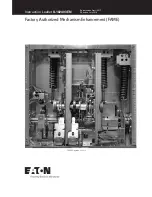
Plus™ and
PM™
Units
1.
Introduction
1-6
Equipment Interfaces
Micro Versa Trip Plus Trip Units
MicroVersaTrip Plus Trip Units do not usually
require connections within the equipment, since all
wiring is contained within the circuit breaker. The
only two connections are for optional zone-selective
interlock (Z1 and Z2) , made by secondary discon
nect, and the neutral sensor, which uses a special
dedicated disconnect.
Zone-selective interlocking coordinates breakers, so
that the downstream breaker is allowed the first
opportunity to clear a disturbance. The two types of
available zone-selective interlocking are Z 1 , which
reacts only to ground faults, and Z2, which reacts to
both ground faults and short-time overcurrent pick
ups.
NeuuaiCurrent Sensors
CAUI10N:
Neutral current sensors are required for
single-phase, three-wire and three-phase, four-wire
systems. When the Trip Unit is connected to a three
phase, three-wire system , the neutral sensor
terminals of the breaker are left open. Do not short
any neutral current sensor terminals in a three
phase, three-wire system, as this could result in dam
age to, or malfunction of, the electrical system.
AITENI'ION:
U n transformateur de courant de
neutre est necessaire pour les reseaux 3 phases +
neutre. Si le neutre n'est pas distribue, les homes de
neutre du declencheur doivent etre laissees ouvertes.
Ne pas les court-circuiter (ceci peut endommager le
declencheur
e t
entrainer
un
mauvais
fonctionnement du systeme electrique.
Micro Versa Trip PM Trip Units
In addition to the inputs received by MicroVersaTrip
Plus Trip Units, MicroVersaTrip PM Trip Units also
receive inputs from external voltage conditioners, a
+24 Vdc control power supply, and communication
connections. External +24 Vdc control power is
required for operation.
6
RMS9C-type MicroVersaTrip PM Trip Units require
a connection to an auxiliary switch within the
breaker that senses the breaker position . This
connection is not required for RMS9D-type
MicroVersaTrip PM Trip Units used on Power
Break® II breakers.
POWER LEADERTM Communication Network
The POWER LEADER Communication Network
(commnet) transmits data and instructions between
the Trip Unit and an external intelligent device. The
external device may be the POWER LEADER system,
the Epic system, or a POWER LEADER Monitor.
Devices on commnet may be up to 1 000 feet apart
without signal repeaters, subject to certain con
straints. A maximum of 30 devices can be connected
without a signal repeater. Refer to GEH-5943 for
installation and operation of the POWER LEADER
system.
Commnet connections are made directly to wiring
terminations on breaker frames. All commnet con
nections to the Trip Units are made through the 36-
pin or 50-pin plug on the Trip Unit, which mates
with a receptacle on the breaker frame. These addi
tional connections are made to the equipment
through the secondary disconnects of the breaker.
Voltage Inputs
Voltage inputs are sensed by conventional instru
ment potential transformers (PTs) . PTs have 1 20 Vac
secondaries and must always be used in groups of
three; no open-delta connections are permitted. PT
primaries are connected either line-to-line or line-to
neutral,
as
required.
PTs may be used for other monitoring functions,
subject to reasonable burden limitations. Note that
PTs must be connected in a specific sequence to
ensure proper phase relations and power-flow sens
ing.
Each PT output feeds an individual voltage condi
tioner that scales the nominal voltage to approxi
mately
1 .76
Vac for use by the Trip Unit.
www
. ElectricalPartManuals
. com















































